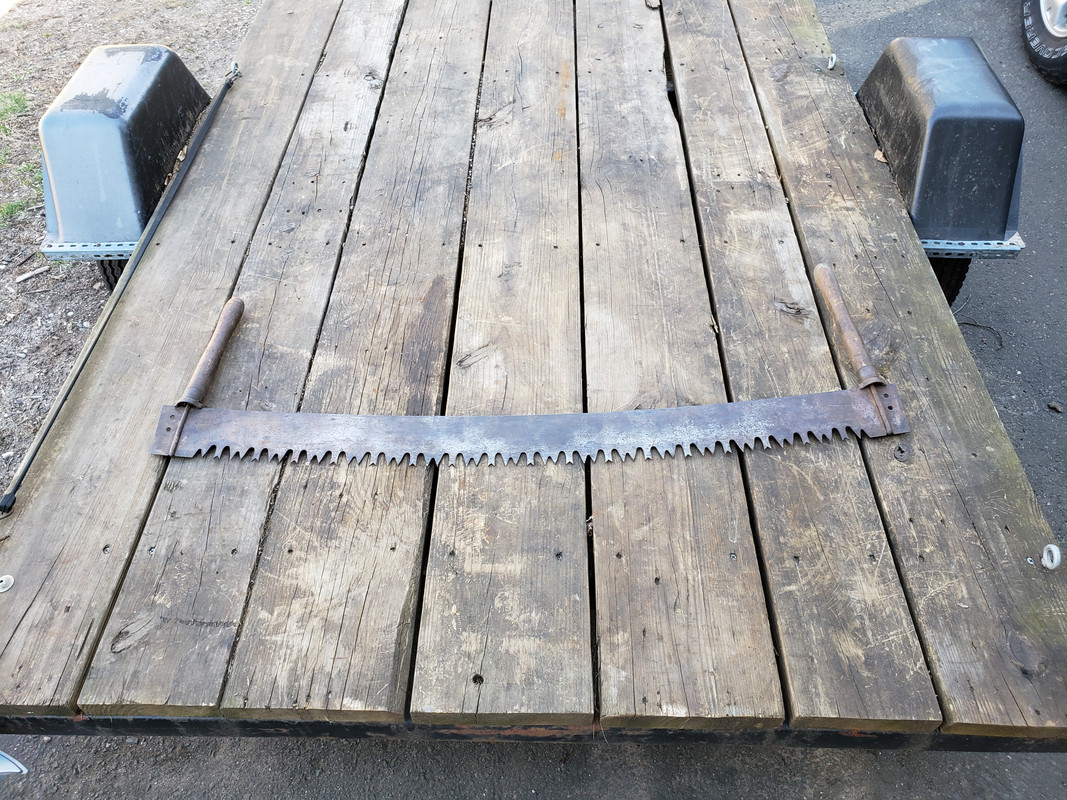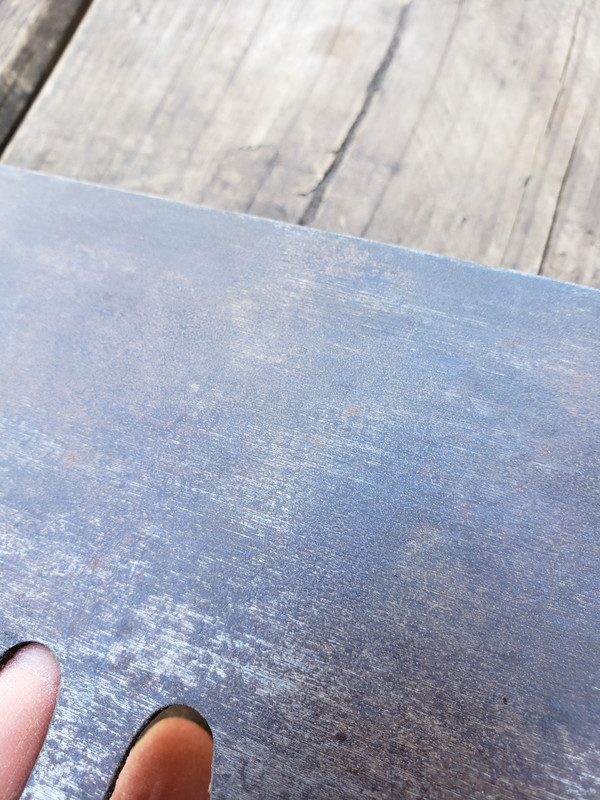-
The BladeForums.com 2024 Traditional Knife is available! Price is $250 ea (shipped within CONUS).
Order here: https://www.bladeforums.com/help/2024-traditional/
You are using an out of date browser. It may not display this or other websites correctly.
You should upgrade or use an alternative browser.
You should upgrade or use an alternative browser.
Crosscut Saw Thread
- Thread starter G-pig
- Start date
- Joined
- Jan 26, 2011
- Messages
- 39
Great thread here gentleman . I’m through page 31 so far . 59 pages to go . I’ve learned a lot ThankYou for the content .
Last edited:
- Joined
- Jul 25, 2017
- Messages
- 2,462
I took down and blocked up some trees for my uncle yesterday (with chainsaws) and I told him that I had just been certified on crosscut saws. He said that I should take the two old saws that he had hanging in his garage.
Here they are:
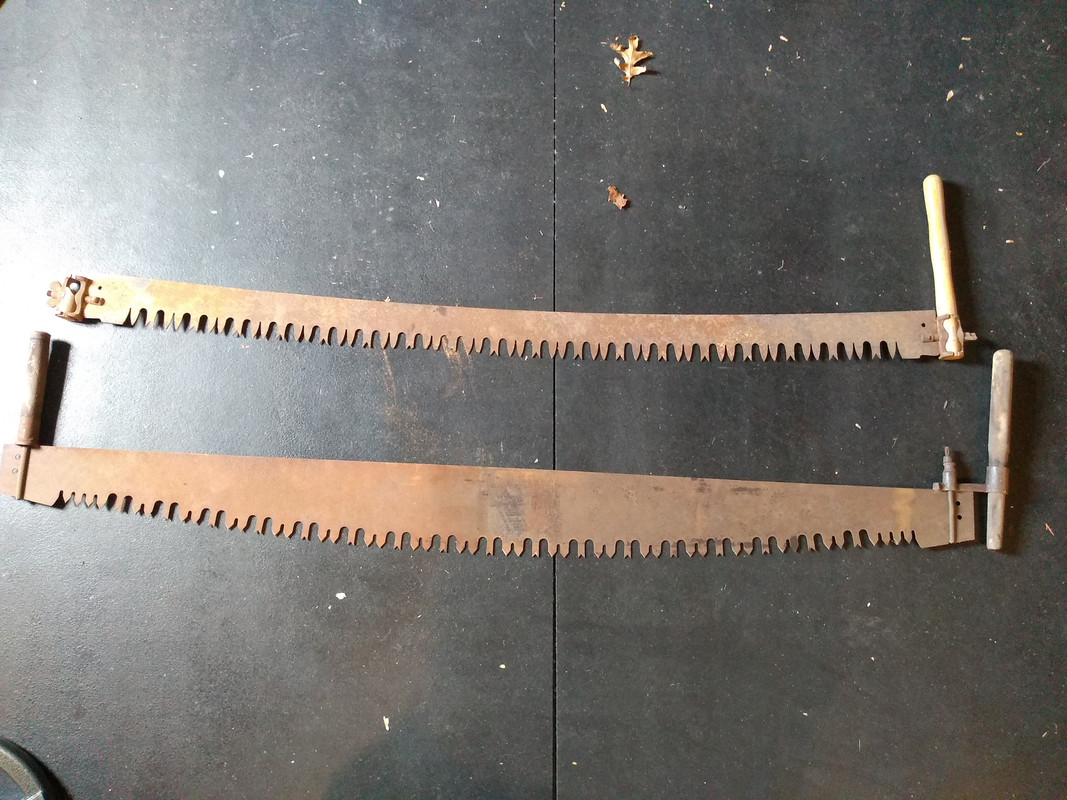
He said the narrow one which I believe is a champion tooth felling saw - was his father's (my grandfather - born 1907) and thought he bought it from LL Bean.
He also said that the wider saw which I believe is a champion tooth bucking saw - belonged to his grandfather (my great grandfather - born 1878) but he didn't know it's origin.
My uncle is 86 and remembers cutting wood with both his father and grandfather with both saws. Said his grandfather would yell at him for leaning into the saw too much.
The teeth on the bucking saw are all in really good shape - and may be a usable saw. However, there are some damaged teeth on the felling saw. both saws are about 6' long.
I have a couple questions.
1. What is the best way to clean the rust from a saw? Can I use a wire wheel as I would with an axe? I'm not sure if there is an etch anywhere under the rust but I would like to preserve it if there is. Seems like a wire wheel would be better than sandpaper, but maybe not. Let me know the least damaging method of cleaning.
2. On the felling (narrow) saw: the handle clamps do have a stamp on them. I believe the stamp is 2 2C or 2 20, but I think it's a C and not a 0 - not sure if that means anything to anyone.
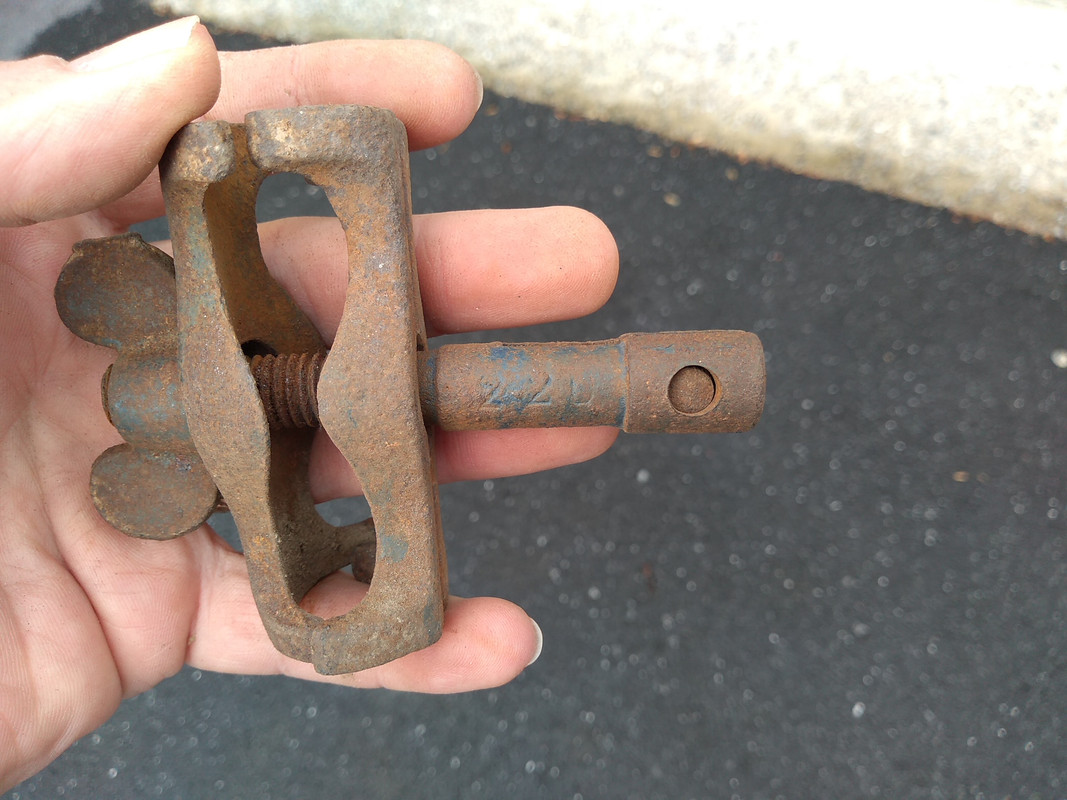
also, on that same saw, the remaining handle has this stamp - it says ___KINS super steel then something I can't read, then 1922. Not sure if the handles are original to the saw, but does anyone recognize this handle stamp?
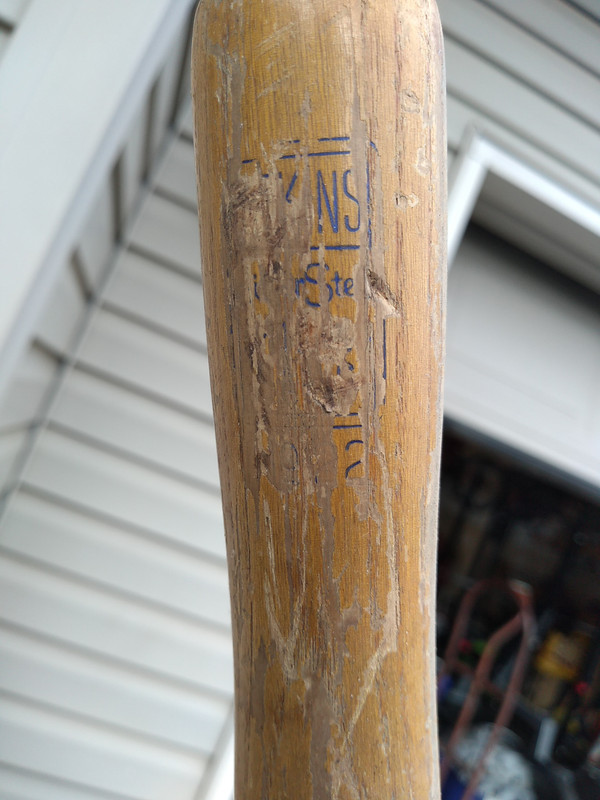
Thanks for any info/input!!
Here they are:

He said the narrow one which I believe is a champion tooth felling saw - was his father's (my grandfather - born 1907) and thought he bought it from LL Bean.
He also said that the wider saw which I believe is a champion tooth bucking saw - belonged to his grandfather (my great grandfather - born 1878) but he didn't know it's origin.
My uncle is 86 and remembers cutting wood with both his father and grandfather with both saws. Said his grandfather would yell at him for leaning into the saw too much.
The teeth on the bucking saw are all in really good shape - and may be a usable saw. However, there are some damaged teeth on the felling saw. both saws are about 6' long.
I have a couple questions.
1. What is the best way to clean the rust from a saw? Can I use a wire wheel as I would with an axe? I'm not sure if there is an etch anywhere under the rust but I would like to preserve it if there is. Seems like a wire wheel would be better than sandpaper, but maybe not. Let me know the least damaging method of cleaning.
2. On the felling (narrow) saw: the handle clamps do have a stamp on them. I believe the stamp is 2 2C or 2 20, but I think it's a C and not a 0 - not sure if that means anything to anyone.

also, on that same saw, the remaining handle has this stamp - it says ___KINS super steel then something I can't read, then 1922. Not sure if the handles are original to the saw, but does anyone recognize this handle stamp?

Thanks for any info/input!!
That says Atkins Silver Steel, I believe.I took down and blocked up some trees for my uncle yesterday (with chainsaws) and I told him that I had just been certified on crosscut saws. He said that I should take the two old saws that he had hanging in his garage.
Here they are:
He said the narrow one which I believe is a champion tooth felling saw - was his father's (my grandfather - born 1907) and thought he bought it from LL Bean.
He also said that the wider saw which I believe is a champion tooth bucking saw - belonged to his grandfather (my great grandfather - born 1878) but he didn't know it's origin.
My uncle is 86 and remembers cutting wood with both his father and grandfather with both saws. Said his grandfather would yell at him for leaning into the saw too much.
The teeth on the bucking saw are all in really good shape - and may be a usable saw. However, there are some damaged teeth on the felling saw. both saws are about 6' long.
I have a couple questions.
1. What is the best way to clean the rust from a saw? Can I use a wire wheel as I would with an axe? I'm not sure if there is an etch anywhere under the rust but I would like to preserve it if there is. Seems like a wire wheel would be better than sandpaper, but maybe not. Let me know the least damaging method of cleaning.
2. On the felling (narrow) saw: the handle clamps do have a stamp on them. I believe the stamp is 2 2C or 2 20, but I think it's a C and not a 0 - not sure if that means anything to anyone.
also, on that same saw, the remaining handle has this stamp - it says ___KINS super steel then something I can't read, then 1922. Not sure if the handles are original to the saw, but does anyone recognize this handle stamp?
Thanks for any info/input!!
ahhh, yes, thanks!!!That says Atkins Silver Steel, I believe.
I wonder if the saw is an atkins as well or just the handles
- Joined
- Jul 19, 2014
- Messages
- 144
I'm a recent convert to a product called Evapo-Rust for removing rust from old tools like these. I've used it on a couple of saws as or more rusted than the ones you show with really great results. After removing my saws from the soak they had a dark patina on them, almost like that of selenium dioxide, but it came off easily with a wire cup brush on my drill. For areas of worse tarnish and pitting I used a sanding/grinding wheel, also on my drill, which worked a treat.1. What is the best way to clean the rust from a saw? Can I use a wire wheel as I would with an axe? I'm not sure if there is an etch anywhere under the rust but I would like to preserve it if there is. Seems like a wire wheel would be better than sandpaper, but maybe not. Let me know the least damaging method of cleaning.
Thanks for any info/input!!
Evapo-Rust at harborfreight.com
Stripper wheel
Last edited:
- Joined
- Jul 19, 2014
- Messages
- 144
Here's one of my current project saws. It's a B3 saw (big bastard bucking saw), five feet long, good taper grind, and 1.5-inch teeth. It still needs some cleaning up, but it's got all of its teeth and I'm looking forward to getting it sharpened and back to work.




- Joined
- Jul 19, 2014
- Messages
- 144
Here's another of my project saws, this one another big ol' bucker. This time I remembered to take a few more pictures during the initial cleaning. It started out as a six foot saw with a nice taper grind and 1.25-inch teeth, but with a broken raker and really gnarly pitting near one end. Evapo-Rust and grinding/sanding later brought it to this state, and then I lopped off the undesirable two feet. Once finished and sharpened I think this will make a great, four foot, bucking saw.
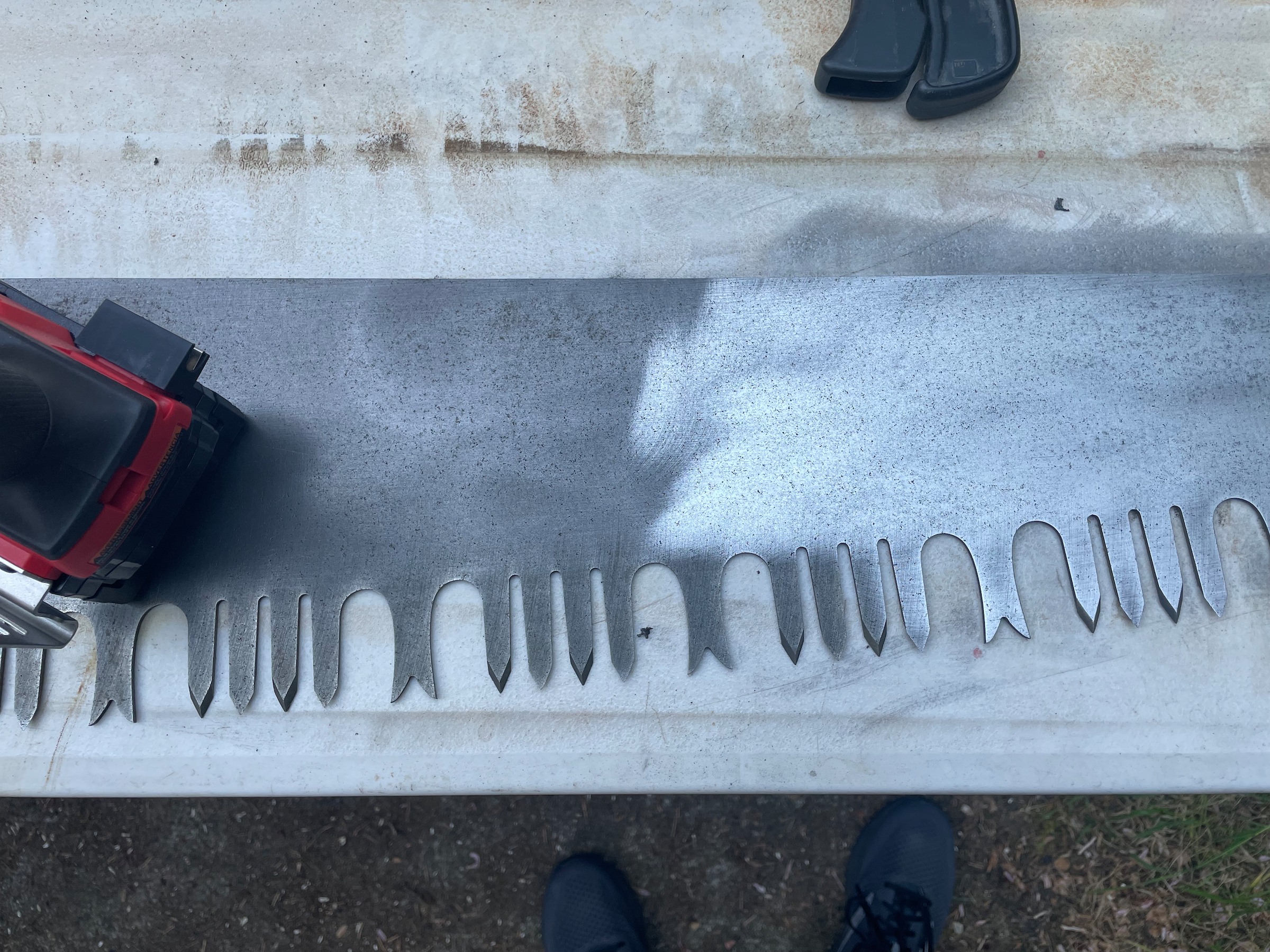















Square_peg
Gold Member
- Joined
- Feb 1, 2012
- Messages
- 13,850
Can you post a picture of the whole saw for perspective? It's hard to judge a saw if all we see is 12" of teeth.Here's one of my current project saws. It's a B3 saw (big bastard bucking saw), five feet long, good taper grind, and 1.5-inch teeth. It still needs some cleaning up, but it's got all of its teeth and I'm looking forward to getting it sharpened and back to work.


- Joined
- Jul 19, 2014
- Messages
- 144
Now that the weather is clearing up I can get back to doing some work on my patio, including on both of these saws.Can you post a picture of the whole saw for perspective? It's hard to judge a saw if all we see is 12" of teeth.
- Joined
- Jul 19, 2014
- Messages
- 144
Two project saws, all cleaned up, and ready to be sharpened. I've got one more to get cleaned up this week and then all three can be sharpened and fine tuned.



And a panning video: http://www.aarongpeabody.com/temp/bladeforums/project_saws_1.mov



And a panning video: http://www.aarongpeabody.com/temp/bladeforums/project_saws_1.mov
- Joined
- Jul 6, 2015
- Messages
- 105
I am having trouble opening the photos, but the video worked fine! Nice saws!
The cut off saw appears to be a Simonds 520. They make excellent trail saws. The upper saw in the video appears, based on the handle hole placement, to possibly be a Simonds 503? The 503 was one of the most popular bucking saws in the northwest prior to the chainsaw!
The cut off saw appears to be a Simonds 520. They make excellent trail saws. The upper saw in the video appears, based on the handle hole placement, to possibly be a Simonds 503? The 503 was one of the most popular bucking saws in the northwest prior to the chainsaw!
- Joined
- Jul 19, 2014
- Messages
- 144
That's good information. Thanks!I am having trouble opening the photos, but the video worked fine! Nice saws!
The cut off saw appears to be a Simonds 520. They make excellent trail saws. The upper saw in the video appears, based on the handle hole placement, to possibly be a Simonds 503? The 503 was one of the most popular bucking saws in the northwest prior to the chainsaw!
I've got a question about saw brands/patterns: a subject I know little about. When you can look at a saw and identify it as something like a "Simonds 520", are you saying for sure that it is a Simonds manufactured and branded saw, something made by Simonds but for another company/brand, or simply to a pattern developed by Simonds? To put it in axe terms, is it a Kelly Perfect Michigan pattern, made by True Temper but sold under another brand, or something that looks very much like a Kelly Perfect Michigan but was probably made by someone else entirely?
- Joined
- Jul 19, 2014
- Messages
- 144
Stepping away, for a moment, from actual crosscut saws, here's a picture of one I created last year. Getting everything just right in my vector graphics program was insanely complicated, but I'm pretty pleased with how it came out. It isn't intended to be a picture of any real saw, but is a composite of a lot of the things I've seen and liked in a variety of saws. Were it real it would fall somewhere in the neighborhood of six-and-a-half feet in length.


- Joined
- Jul 6, 2015
- Messages
- 105
Generally speaking, crosscut saws are referred to by the actual maker. In the case of the Simonds 520, it is a fairly distinct pattern - the tooth spacing is a little closer, with the rakers being on about 4" center to center, and the small notches on the back of the saw about 2-1/4" from the ends. I've only encountered 2 examples of this pattern that are marked with another manufacturer - one Disston, and one Sandvik - out of well over 100 saws with visible logos. "House brand" saws, like Montgomery Wards, Sears Craftsman, and various hardware companies, almost always had their saws made by one of the major makers, like Simonds, Disston, Atkins, or Curtis.I've got a question about saw brands/patterns: a subject I know little about. When you can look at a saw and identify it as something like a "Simonds 520", are you saying for sure that it is a Simonds manufactured and branded saw, something made by Simonds but for another company/brand, or simply to a pattern developed by Simonds? To put it in axe terms, is it a Kelly Perfect Michigan pattern, made by True Temper but sold under another brand, or something that looks very much like a Kelly Perfect Michigan but was probably made by someone else entirely?
Axe manufacturers - and there were hundreds... - often copied patterns, but the company names are protected by copyright. If the axe is marked you can be reasonably assured who made it!
Does anyone know of a source for replacement wood handles for crosscut saws? I need one handle to fit a climax type handle attachment. I have the hardware, I just need the wood handle.
I found that Beaver Tooth has them, but says they have a 30 day shipping delay - which seems a little excessive. I could understand something like that this time last year, but not now.
Everywhere else I've seen sells the handles with the hardware.
I found that Beaver Tooth has them, but says they have a 30 day shipping delay - which seems a little excessive. I could understand something like that this time last year, but not now.
14
14" Beaver Tooth Climax Style Crosscut Saw Handles. Listing is for a Pair of handles. Approx. 14" long, hole for your blade bolt. These will look great with your hardware and finish off your saw project. Made in USA.
beaver-tooth.com
Everywhere else I've seen sells the handles with the hardware.
Been a while since I've posted here. Where do you live? I was in the south for a long time and would cut hickory branches of the approximate diameter for saw handles. Branches grow straight and round and can be fitted to any handle hardware. Can't beat hickory as a handle wood and the added pleasure of DIY makes it a personalized handle.Does anyone know of a source for replacement wood handles for crosscut saws? I need one handle to fit a climax type handle attachment. I have the hardware, I just need the wood handle.
I found that Beaver Tooth has them, but says they have a 30 day shipping delay - which seems a little excessive. I could understand something like that this time last year, but not now.
14
14" Beaver Tooth Climax Style Crosscut Saw Handles. Listing is for a Pair of handles. Approx. 14" long, hole for your blade bolt. These will look great with your hardware and finish off your saw project. Made in USA.beaver-tooth.com
Everywhere else I've seen sells the handles with the hardware.

